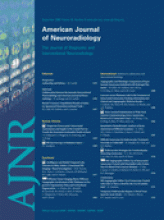Abstract
BACKGROUND AND PURPOSE: The diagnosis of dural arteriovenous fistula (DAVF) remains one of the few uncontested indications for catheter based cerebral angiography. We report our experience of using a commercially available form of time-resolved MR angiography (trMRA) at 3T for the diagnosis and classification of a cranial DAVF compared with the reference standard of digital subtraction angiography (DSA).
MATERIALS AND METHODS: A retrospective review of our patient records identified patients who had undergone trMRA at 3T and DSA for the evaluation of DAVF. The trMRA consisted of whole-head, contrast-enhanced “time-resolved imaging of contrast kinetics” (TRICKS) MRA. Image sets were independently reviewed by 3 readers for the presence, location, and classification of a DAVF. The reported result of the DSA was used as the gold standard against which the performance of the trMRA was measured.
RESULTS: Forty patients were identified who had undergone DSA and trMRA for evaluation of DAVF, yielding a total of 42 cases. On DSA, the results of 7 cases were normal, 15 cases were performed for surveillance of a previously cured fistula, and a new fistula (14) or persistent (6) fistula was found in 20 cases. Of these 20 fistulas, on DSA, 13 were Borden I, 2 were Borden II, and 5 were Borden III. In 93% (39/42) of DAVF cases, the 3 readers were unanimous and correct in their independent interpretation of the trMRA, correctly identifying (or excluding) all fistulas and accurately classifying them when encountered.
CONCLUSIONS: In this small series, trMRA at 3T seems be a reliable technique in the screening and surveillance of DAVF in specific clinical situations.
- Copyright © American Society of Neuroradiology
Indicates open access to non-subscribers at www.ajnr.org












